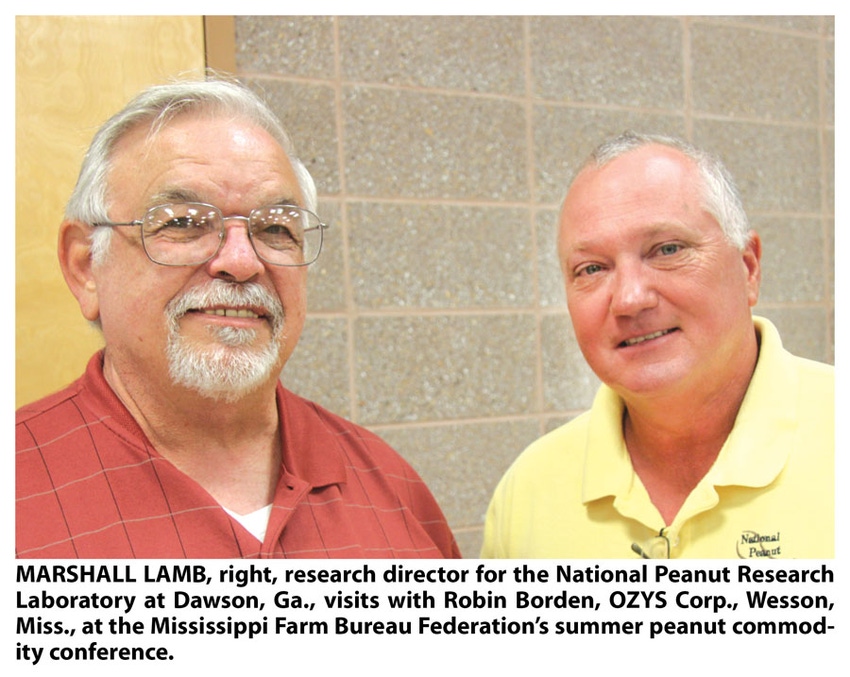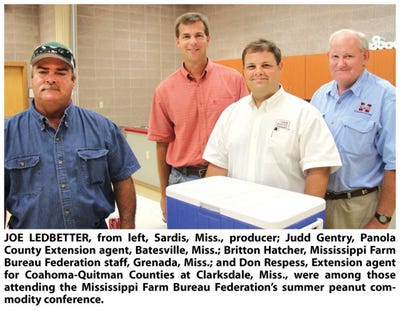
A lot of uncertainties remain as to how 2012 peanut crop will turn out
“When peanut carryover gets down to 500,000 farmer stock tons, that is extremely tight — as tight as we want to get in terms of marketing," says Marshall Lamb, research director at the National Peanut Research Laboratory, Dawson, Ga. "Manufacturers get nervous, shellers get nervous, and that’s why in 2011 uncontracted peanuts pushed up to $1,000 per ton," he said at the Mississippi Farm Bureau Federation's summer peanut commodity conference.

A roller coaster ride — that’s how Marshall Lamb describes the peanut industry for the past decade starting with the 2002 farm bill.
It has been characterized by market dips brought on by overproduction, followed by acreage cutbacks and lower production that then result in an upward market price trajectory, then a repeat of the cycle, says Lamb, who is research director of the USDA/ARS National Peanut Research Laboratory at Dawson, Ga..
“Right now, we’re in a very dynamic situation,” he said at the Mississippi Farm Bureau Federation’s summer peanut commodity conference at Grenada, Miss.
“We’re coming off two years, 2010-2011, that were marked by drought and very high temperatures in major production areas, which had an impact on peanut quality and supply,”
That reached a culmination in 2011, when severe drought in Texas sharply reduced production and shot the peanut market roller coaster dizzingly upward.
“With only 1.8 million tons produced and an edible supply just under 500,000 farmer stock tons (FST), and imports at roughly 70,000 tons, that left us with only a 2.4 million FST supply to work with. From 3 million FST in 2010 to 2.4 million in 2011 is a pretty steep drop.
“The crush was also a little higher in 2011, which left us with a carryout of only 207,000 FST. In the U.S., we have a shelling capacity of about 165,000 tons per month. Over a three-month period from August through October, the industry needs about 500,000 FST of carryover in the pipeline in order to keep the mills running and full until new crop deliveries come on board.
“When carryover gets down to 500,000 FST, that is extremely tight — as tight as we want to get in terms of marketing. Manufacturers get nervous, shellers get nervous, and that’s why in 2011 uncontracted peanuts pushed up to $1,000 per ton.
“Shellers and manufacturers were scrambling to get peanuts that weren’t already secured. That’s also why, going into 2012, we were seeing contracts around $700 to $750 per ton — because they wanted to make sure there would be enough acreage going into the season to get this undersupply situation off our backs.”
No contracts are currently being offered for 2012 peanuts, Lamb says, because “it’s too early to tell which way this crop is going to go.
“From this point forward, yield will determine where we are in terms of the fall market. Don’t expect a contract to come out anytime soon. Manufacturers want to see where this crop is going, so they won’t support the shellers right now to go out and contract peanuts. And shellers can’t afford to go out on a limb and speculate where this crop is going without having the backing of the manufacturers. All of which means no offer is going to trickle down to farmers right now.”
A lot of uncertainties exist, Lamb says. “Yield and quality of this crop have a long way to go. We’re on a seesaw right now, and it’s balanced about in the middle. The question is, which way is it going to go — up or down? We’ve never made or lost a crop in June; it’s just too early to tell.”
Another factor that may influence the market, he says, is imports. Last year, peant imports totaled about 70,000 tons; this year, that could be cut in half.
New opportunities in Europe?
“The Argentine crop has been negatively affected by weather all year,” he says. “They’re in their harvest now, about 50 percent finished. They had a tremendous drought, followed by rain and freezing weather, all of which will reduce their crop. How they will finish will impact their exports. A lot of their peanuts that might have come to the U.S. will go to satisfy European demand.
“If they can’t fill all that European demand, there could be some new opportunities for U.S. peanuts to get into that market, which would also help in the event we have an oversupply this year.”
How will things stand at the end of the current marketing year July 31?
“A lot of people say we’ve got too many peanuts planted this year,” Lamb says. “I’m not one of those.
“If we bring forward 210,000 FST from 2011, have 1.45 million planted acres for 2012, and if we average 3,350 pounds per acre, we’ll produce a crop of roughly 2.4 million FST this year. That would give us a total supply to work with of roughly 2.6 to 2.7 million FST.
“Assuming a good average demand of 2.1 million FST, carryforward going out of this marketing year would be about 571,000 tons. That’s not a flood of peanuts. It would get us back to a comfortable level, as far as having enough peanuts to supply the market.
“But, what if we get good weather and rains and have a yield average in the 3,550 pound range? That still won’t flood the market, in my opinion. It would mean production of 2.5-2.6 million FST, which would give us carryout of 716,000 FST. We’ve been near that level before, so we still would be oversupplying.
“Conversely, what would happen if things should go downhill a bit and we average only about 3,150 pounds per acre? That’s roughly 2.3 million FST of production, which would give us a 2.5 million FST supply. Take out demand and we’d be at 426,000 FST carryforward.
“If we can shell 165,000 tons per months, that’s 495,000 tons we’d need for carryout. If that should happen, we’d be right back where we were in terms of the market being a little short in terms of carryforward.”
Last year, Lamb says, “We were in the middle of a perfect storm in terms of supply/demand. We’re still sort of in the middle of that storm, but in my opinion, we’re slowly coming out of it.”
If yields this year are average to above average, he says, some uncontracted peanuts could be forced into the loan.. “I’m not so sure I’d be afraid of that. Right now, we have a drought going on in the Midwest, and we’ve seen its impact on major commodity prices: corn, soybeans, and wheat prices all up strongly. That kind of scenario affects all of us. “If we get wheat and beans and corn fighting for acres, that will be direct competition for land that peanuts are grown on. If cotton gets back to 80 cents or above, that will have an effect, too. What happens in the Midwest will have an impact on peanut acreage.
“If the drought lingers, next spring when manufacturers and shellers are trying to contract peanuts to be planted in 2013, they’re also going to want to be getting those peanuts out of the loan. If it’s dry in the Midwest, prices of peanuts will go up if the competition for land stays strong. So, don’t be afraid to put some peanuts in the loan if these other commodity prices stay high.”
Looking at the three possible yield scenarios— average, below average, and above average — “none of them indicate that we’re going to flood this market,” Lamb says. “We may have a slight oversupply, or we may hit it right on the money, but the potential is there for undersupply as well.”
About the Author(s)
You May Also Like



